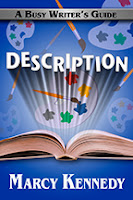Part of the Indie Author Series
Welcome back to my ongoing series on advertising as an indie author.
If you haven’t read all the previous posts in this series, I recommend you start from the beginning. We’ve already looked at a big picture overview of when and what we might want to advertise, and we talked about whether there’s ever a time when it’s okay to lose money on advertising.
Then I threw you into the math deep-end because we needed to figure out whether we’re earning or losing money on our ads and how read-through affects our investment.
Last month we moved on to one of the different options available to us for advertising—newsletter ads.
This month I’m continuing on with “pay-per” ads.
Understanding “Pay-Per” Ads
For our purposes, there are two types of “pay-per” ads we need to understand: pay-per-click ads and pay-per-impression ads.
The fundamental difference between them is probably obvious just based on the name, but I’ll explain them anyway just in case.
Pay-per-click ads could also be called CPC or cost-per-click ads. We only pay when a viewer clicks on our ad. While this doesn’t guarantee they’ll buy our book, it does mean that we’re only paying when someone was interested enough to want to learn more.
Pay-per-impression ads have a cost based on how many people see our ads. You might also hear them called CPM ads (cost per mille – a fancy way of saying cost per thousand impressions). We’ll generally only be charged the first time someone sees our ad, but these ads can be more difficult to see a return on investment on if we’re not careful.
CPC and CPM ads are used widely, but as indie authors, the platforms we’re most interested in are likely Amazon Marketing Services, Facebook, and BookBub.
Amazon Marketing Services Ads
Amazon Marketing Services (AMS) ads are pay-per-click ads. This is one of their best features in my opinion. Amazon is the largest book seller in the world. By running AMS ads, people are seeing our book even if they aren’t clicking, and they’re seeing them on a platform they’ve visited with the intent to purchase something. That’s basically exposure for free, and we don’t know how many times someone will need to be exposed to our book before deciding to read it.
AMS offers two forms of ads—sponsored product ads and product display ads.
Sponsored product ads appear in Amazon search results. They’ll also show up on product detail pages that you’ve targeted with your keywords underneath the Also Bought books. I’ve found them to be the more effective of the two forms of AMS ads because they allow you to select up to 1000 keywords per ad. The keywords can include author names and book titles, as well as more general phrases. You can select the amount you’re willing to pay per click on each individual keyword if you want to be that specific, and you can remove or add keywords at any time to make your ad more effective.
Product display ads allow you to target individual products or an interest, but you can’t create the long list of keywords you’re able to use with a sponsored product ad. These ads show up on the pages of those selected products underneath the buy button. If you choose to target by interest, your ad will also be shown on readers’ Kindles. Product display ads, in my experience, haven’t been as effective as sponsored display ads. I suspect it’s because they don’t show up in search results the way sponsored product ads do. Once someone is on a product page, they’re likely to buy that product rather than clicking away to a different product.
AMS ads have a couple of annoying features. Their reporting is horribly slow, taking anywhere from days to a week before you know if your ad is performing well or not. They’ll also sometimes stop showing high-performing ads for no discernable reason.
If you want to learn more about AMS ads, I recommend Mastering Amazon Ads by Brian D Meeks.
Facebook Ads
Facebook ads have a lot of customization options, so you can choose whether you want them to be CPC or CPM ads. CPC ads are the better choice since it means you only get charged when people actually make a click. On Facebook, that’s very important because having your ad “seen” doesn’t necessarily mean it was paid attention to.
Facebook ads can be powerful because of how large a platform it is. Facebook has over one billion active users, and 70% of those users check in daily. Facebook also allows us to get very precise with our targeting.
Our ads will show up either within a user’s newsfeed or in the static bar on the right-hand side (depending on what we select). Most people have found the newsfeed ads to be more effective because they feel more organic and less like an ad.
Facebook ads are also one of the most challenging. This platform is crowded right now, and you can lose a lot of money while testing your ads because Facebook sets a minimum daily budget of $5. (In comparison, AMS ads have a minimum daily budget of $1.)
An additional challenge with Facebook ads is the visual element. You have to create your own graphics (or video) to go along with your ad or you need to hire someone to do it. Not only does that increase your upfront cost, but it also increases your time investment, especially if you’re split testing your ads by trying multiple different graphics.
If you want to learn more about Facebook ads, I recommend HELP! My Facebook Ads Suck by Michael Cooper.
BookBub Ads
Most authors think of Featured Deal newsletter ads when they hear the name BookBub, but BookBub also allows authors to do pay-per-impression ads as well. These ads are shown at the bottom of the daily newsletters that BookBub sends out to their subscribers.
The biggest benefit of BookBub ads seems to be that you’re able to get your ad in front of an audience of avid readers without having to go through the editorial review and approval-rejection process required when applying for a Featured Deal. (You are required to apply to be able to run ads. I only recently got my acceptance, so I’m still exploring this platform myself.)
The biggest drawback is that BookBub ads charge you based on impressions rather than clicks. This means a poorly designed ad could result in you losing a lot more money than it would if you were running it on Facebook or AMS.
If you want to learn more about BookBub ads, I recommend listening to this episode of the Science Fiction and Fantasy Marketing podcast.
Have you tested CPC or CPM ads? What were the biggest challenges you faced in making them successful?
 Marcy Kennedy is a mystery and speculative fiction writer who believes fantasy is more real than you think. Alongside her own writing, Marcy works as a freelance fiction editor and teaches classes on craft and social media. She’s also the author of the Busy Writer’s Guides series of books. You can find her blogging about writing and about the place where real life meets science fiction, fantasy, and myth at marcykennedy.com.
Marcy Kennedy is a mystery and speculative fiction writer who believes fantasy is more real than you think. Alongside her own writing, Marcy works as a freelance fiction editor and teaches classes on craft and social media. She’s also the author of the Busy Writer’s Guides series of books. You can find her blogging about writing and about the place where real life meets science fiction, fantasy, and myth at marcykennedy.com. Blog | Facebook | Twitter | Amazon | Apple iBooks | Barnes & Noble
About Description
 Description in fiction shouldn’t be boring for the reader or for the writer.
Description in fiction shouldn’t be boring for the reader or for the writer. Description: A Busy Writer’s Guide will help you take your writing to the next level by exchanging ho-hum description for description that’s compelling and will bring your story to life, regardless of the genre you write.
In Description: A Busy Writer’s Guide, you will
- find the answer to the age-old question of how much description is too much;
- learn how to use point of view to keep description fresh;
- recognize the red flags for boring description in fiction;
- explore how to use all five senses to bring your descriptions to life for the reader;
- discover the ways metaphors and similes can add power to your descriptive writing;
- gain the tools needed to describe setting, characters, and action in engaging ways;
- learn how descriptions can add conflict, enhance the theme, and amp up emotion; and
- much more.


No comments:
Post a Comment